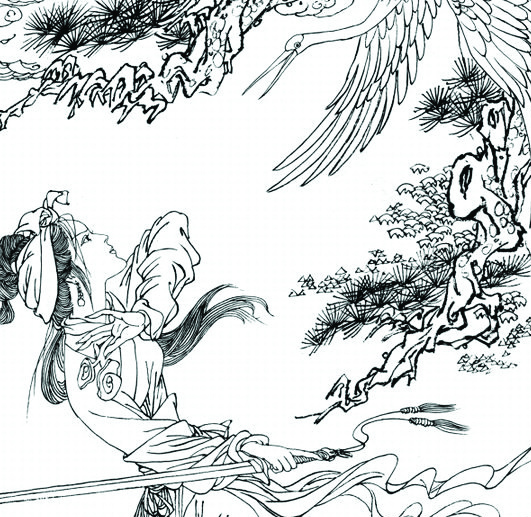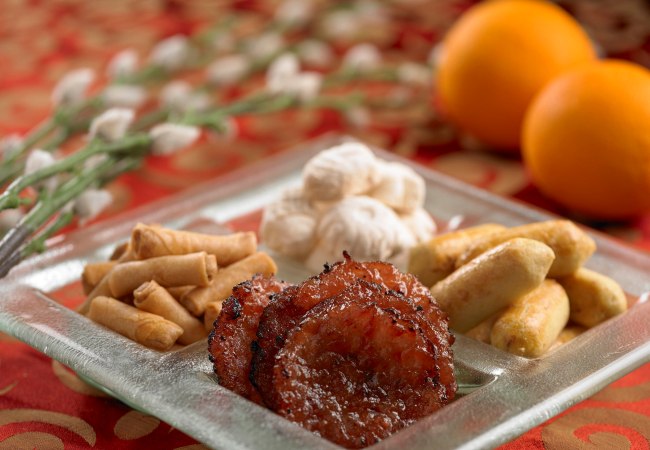The Origin and Legends of the Mid-Autumn festival
Following the article on Customs of Mid-Autumn Festival, let us look at the Origins and Legends associated with this Chinese festival.
Origin
Like many festivals, the Mid-Autumn festival came to its current traditions through many years of evolution. The history of Mid-Autumn festival in China can be dated back to around 500 BC where the term “Mid-Autumn” was found mentioned in a classic written by Confucius.
Ancient Emperors in China followed a custom of praying to the Sun in Summer and to the Moon in Autumn. This custom was later adopted by the royalties and scholars and eventually by the commoners too, hence becoming a mass tradition. By the Tang dynasty (A.D. 618 – 907) this tradition became officially stated as a festival. It gain popularity during the Song dynasty (A.. 960 – 1279) and by Ming dynasty (A.D. 1368 – 1644) became as popular and important as the Spring Festival (Chinese New Year).
Legends
The Mid-Autumn festival has many rich and ancient legends associated with it. These mythical tales enrich the festive atmosphere with interesting stories and histories and also adding a weave of mystery behind it.
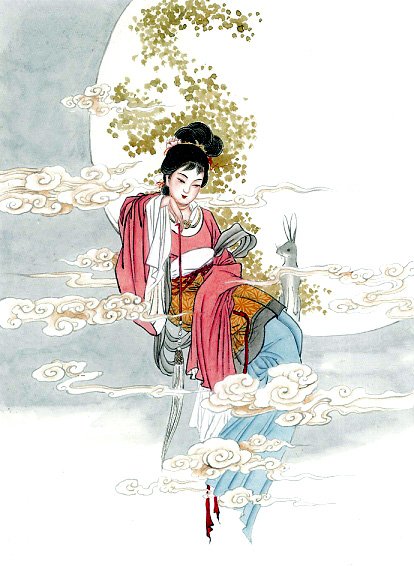
Legend of the Chang Er (嫦娥奔月 : cháng é bēn yuè)
Of the many legends, the one on Chang er is the most famous. There are a few versions of the story on how Chang er ended up on the moon. Below is one popular version.

Legend goes that in ancient China, the sky suddenly appeared ten Suns. The ten scorching suns burnt the lands, ruining crops and drying rivers. Just as the situation was at its direst and all seemed lost for the people on earth, a hero appeared. His name was Hou Yi. With his bow and arrows, he ascended the peak of Kun Lun Mountain and using his mighty strength and godly archery skills, he shot down nine of the suns.
The land and its people were saved from the catastrophe and Hou Yi became honoured as a saviour. Many people came to become his archery disciplines, but among his students, there was a cunning and devious man called Peng Meng.
Soon Hou Yi married Chang Er, a beautiful and kind girl. Other than teaching archery classes, Hou Yi spent his time with Chang Er and they were much adored and admired as a loving pair of couple.
One day, as Hou Yi was travelling to Kun Lun Mountain to visit a friend, he chanced upon the Jade Empress, a heavenly goddess. To the Jade Empress, he requested and was given the pill of immortality, which was able to transform a moral into a deity.

Hou Yi was reluctant to leave his wife alone on earth however and passed the pill of immortality to Chang Er for safekeeping. The devious Peng Meng overheard about the pill and wanted it for his selfish means. Whilst Hou Yi was out hunting with his other disciplines, Peng Meng stormed into their house with a sword in his hand and demanded Chang Er to give him the pill of immortality. Unable to fight against Peng Meng and afraid that he would use the pill for evil purposes, Chang Er swallowed the immortality pill.
Immediately, Chang Er became light and started to float out the window. She flew up the sky beyond her control. As she flew higher and further from earth, she yearned badly to see her husband again. Hence, seeing the moon being the nearest heavenly land from earth, Chang Er landed and stayed on the moon.
When Hou Yi came back in the evening and knew of the incident, he was extremely upset. Dashing out to the backyard garden, he yelled out his wife’s name in sadness. Suddenly, he noticed that the moon was brighter than normal and he could notice a familiar shadow moving on the moon, much resembling his beloved wife, Chang Er.
Hou Yi realized that Chang Er had become a deity on moon. He set up an incense altar below the moonlight and placed her favourite fruits and snacks as a memorial for Chang Er. Word spread that Chang Er has become the moon deity and people have since every Mid-Autumn place offerings and pray to the moon for the kind-hearted Chang Er to grant peace and happiness to them.
Jade Rabbit Who Pounds Medicine (玉兔捣药 : yu4 tu4 dao3 yao4)
Although sad and lonely, Chang Er is not the only one on the moon. She is accompanied by Jade Rabbit and Wu Gang the woodcutter. You can often see on mooncake packaging, drawings of Chang Er and a cute white fluffy rabbit. How the rabbit came to live on the moon also has a story.
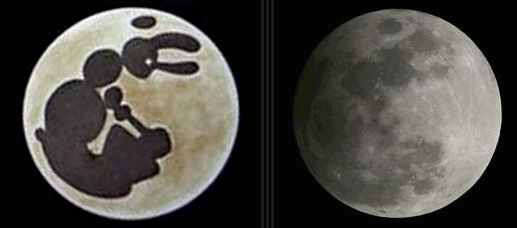
There are several versions to the story. One claims that the rabbit is in fact Chang Er herself. One says that Hou Yi transformed into Chang Er’s favourite animal, a white rabbit to keep her company on the moon. And another mentioned a rabbit fairy, sympathizing on Chang Er’s plight, sent his youngest daughter to keep her company. Below is yet another version.
In this legend, three gods descended on earth and disguised themselves as three pitiful old men. They met fox, monkey and rabbit and asked them to spare them some food. Both the fox and monkey did so.
However, the rabbit had no food, hence it told the three old men to eat itself. Shortly after, it jumped into the fire. The gods were greatly moved and made the rabbit live immortally in the moon palace.
No matter what version the story is, the jade rabbit’s task on moon was to pound and create the pills of immortality. It is also sometimes said that Chang Er, missing dearly her husband on Earth, asks Wu Gang the woodcutter (with his wood for fuel or ingredient) and the Jade Rabbit to help create a magical pill to allow her to fly back to earth to reunite with Hou Yi.
Wu Gang chopping the Osmanthus Tree (吴刚伐桂 : wu2 gang1 fa2 gui4)
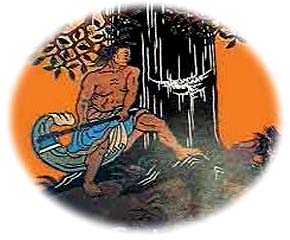
Also stuck on the moon, Wu Gang is made to chop down an osmanthus tree in the moon palace by the Jade Emperor. However, this tree magically heals itself from any damage and hence it has become an eternal punishment for Wu Gang to chop on the tree that never falls.
Another version tells of Wu Gang as the protector of the osmanthus tree on moon. And it was he who handed down the seeds of the tree to earth. Without him, the humans would have no osmanthus trees to make the fragrant osmanthus tea and osmanthus flavoured wine.
Legends on the Moon cakes
Having read so many tales about deities and animals on the moon, what about the origin of the mooncake? There are two tales on how this delicious sweet festive pastry is derived.
The 1st one is based on the story of Chang Er. Yearning to meet her husband again, Chang Er instructed Hou Yi to, on the day of full moon, create a pill made of flour, as round as the moon. He was to place this flour pill at the west side of the house and call out her name. As promised, on the night of full moon, Chang Er flew down to reunite with him once every Mid-Autumn. The mooncake tradition then evolved from there.
Zhu Yuan Zhang Mooncake Rebellion (朱元璋与月饼起义 : zhū yuán zhāng yǔ yuè bǐng qǐ yì)
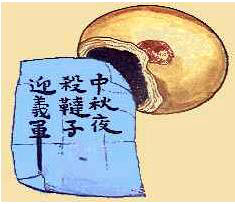
The 2nd tale is set in the late Yuan Dynasty (A.D. 1279 – 1368). This is a famous legend about Zhu Yuan Zhang who gathered the masses to rebel against the tyrannical Yuan government. However, the Yuan soldiers conducted stringent checks which made communication among the rebel groups difficult.
Liu Bo Wen, his strategist, then came up with an idea. He instructed the writing of”八月十五夜起义” (Rebellion on the 15th day of the 8th month) on slips of paper which were then stuffed into pastries. These boxes of pastries with the secret message on the date of rebellion were sent to the ally forces without notice from the Yuan soldiers.
On the fateful day (which is set on the Mid-Autumn day), Zhu Yuan Zhang led a successful rebellion and founded the Ming Dynasty. Since then celebrations on the Mid-Autumn Festivals included these mooncake pastries to commemorate the event.
Legend behind the Fire Dragon Dance
Lastly the famous Tai Hang Fire Dragon Dance (舞火龍: wǔ huǒ lóng) in Hong Kong also has a historical legend. It is said that in the 1880s on a Mid-Autumn eve night, a typhoon slammed Tai Hang Village in Hong Kong. A giant python appeared and ate many of the village’s domestic animals. The villagers gathered and killed the python, after which, the typhoon subsided too.
However, the corpse of the python mysteriously disappeared and soon an epidemic of plague engulfed the village, killing many of the people. A priest then came. He explained that the python was originally the son of the Sea Dragon. The death of his son angered the Sea Dragon so much that he brought forth the disaster upon the village and its people.
An old man from the village claimed that a heavenly deity came to his dream and taught him how to counter the Sea Dragon’s spells. He was told that the Sea Dragon feared the Fire Dragon and fire element the most and hence for three consecutive nights on Mid-Autumn festival, a Fire Dragon Dance is held.

In this dance, a dragon head with a long segmented dragon body and a tail is controlled by several dancers. The dragon structure is stuck all over with lit red coloured incense sticks to symbolize the fire element. After the dance, the plague was controlled. And since then, the tradition of the Tai Hang Fire Dragon Dance during every Mid-Autumn festival lived on even til now.
Regardless how true the legends are, as you savour your mooncakes and enjoy the full moon scenery, these traditional stories will make good tales to entertain your family and friends.
Related Posts:


